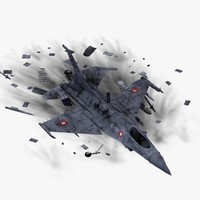Emergency procedures
In BMS there are no random failures of your jet. This is a good thing. The bad thing is there is a complex system of inter-related faults and problems that can arise when you either A: get shot, or B: do something stupid.
Learning objectives
- Learn how to recognize faults
- Know how to avoid faults
- Recover from stalls
- Use an emergency checklist
Learning files
- BMS 4.33 Dash 1 SECTION III (p168)
- BMS-Training.pdf mission 7 (p62) and mission 9 (p78)
- F-16 Loss of Control, Test Pilot on Yaw Departure
Emergency situations
The most common problems caused by battle damage will be loss of one or more navigation systems, or damage that reduces the capability of your engine. You should familiarise yourself with the various backup systems available, not only in the jet but on the ground in terms of TACAN frequencies, alternative landing fields etc.
There are 3 basic rules to be followed in any in-flight emergency:
- Maintain aircraft control
- Find out what is wrong
- Land as soon as the situation dictates
This can happen on ingress to a mission and mean you will need to abort. This is a tough call but there’s no point in nursing a half dead aircraft into a situation where you can’t effectively defend yourself or your partner. You should RTB as soon as possible. You should not RTB alone, your wingman will accompany you and keep an eye on you.
Systems
The warning/caution system is made of different subsystems:
- Warning lights (amber lights on the eyebrows)
- MASTER CAUTION (press to reset amber light on the left eyebrow)
- Caution lights (yellow lights on the right auxiliary console caution panel)
- PFLD (Pilot Fault List Display - small screen on the right auxiliary console accessed with the F-ACK button on the left eyebrow)
- Maintenance Fault List
- VMS (Voice Message System – aka Bitching Betty)
- HUD messages
The Master caution light will come on to alert you to a condition. It means: look at your caution panel now. Do not just press the Master caution light, it will not clear the fault.
The subject of Emergency procedures is huge and the pilot should work through the material provided with the sim to gain a proper understanding. I will attempt to cover the most common problems you will encounter and explain how they can be dealt with.
To do
- Exceeding g-limits or airspeed for stores
- Engine damage
- Engine failure in flight
- FLCS failure
- Radio failure
- Nav failure
- HUD failure
- Gear failure

